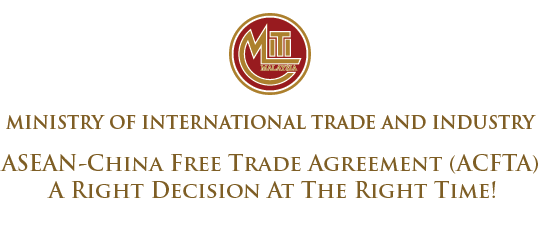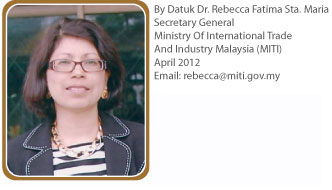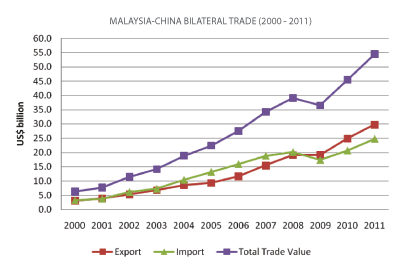Ministry Of International Trade And Industry ASEAN-China Free Trade Agreement (ACFTA): A Right Decision At The Right Time


The signing of the ASEAN-China Free Trade Agreement (ACFTA) in 2004, marked a major milestone in ASEAN-China economic relations. It was ASEAN’s first FTA. It heralded the integration of one of the fastest growing regions with an equally fast growing emerging economy. ACFTA is collectively a market of over 1.9 billion with a combined GDP of US$7.6 billion. ASEAN’s GDP of US$1.8 billion represents 32% of the GDP of China. In terms of purchasing power parity, the combined GDP of ASEAN and China is US$13 trillion. In fact, ACFTA is one of the largest free trade areas in the world.
To a large extent the decision to embark on this initiative has paid off. With the strengthening of relations, China has today surpassed the US and the EU to be ASEAN’s largest trading partner. The share of China’s trade with ASEAN rose from 4.3% in 2000 to 11.3% in 2010.
ASEAN-China trade increased from US$130.4 billion in 2005 when the Trade In Goods Agreement of ACFTA entered into force in July 2005 to US$362.85 billion in 2011. According to Chinese statistics for 2011, ASEAN is now China’s third largest trading partner compared with 2005 when ASEAN was its fifth largest trading partner.
Tariffs are no longer a hindrance to the expansion of trade between ASEAN and China. Tariffs have been gradually eliminated or reduced under the ACFTA. On 1 January 2012, ASEAN-6 (Brunei, Indonesia, Malaysia, the Philippines and Singapore) and China eliminated import duties on over 90% of the products.
With tariffs out of the way, ASEAN and China are intensifying work to address issues related to sanitary and phytosanitary and technical barriers to trade. The Protocol to incorporate sanitary and phytosanitary measures and technical barriers to trade into the agreement on Trade In Goods of the ACFTA is scheduled to be signed at the ASEAN-China Summit in November 2012. The objective of the Protocol is to strengthen cooperation and facilitate and promote Trade In Goods by ensuring that technical regulations, standards and conformity assessment procedures are in place to facilitate trade.
Besides trade, the services sectors were also given a boost with the relaxation of equity conditions under the ASEAN-China Trade In Services Agreement, signed in 2007.
From the perspective of investments, the ASEAN-China Investment Agreement was signed in 2009. Chinese Foreign Direct Investments in ASEAN continue to increase, from US$1.51 billion in 2009 to US$5.91 billion in 2011. However, this is still not as significant as that of the EU, Japan and the US.
What started out as an initiative to deepen trade and investment ties has today grown into a strategic one, mutually reinforcing and covering not only trade and investment but a wide range of sectors including transport, agriculture, standards and conformance, telecommunications and tourism.
Despite the challenges of the uncertainties prevailing in the global economy, ASEAN and China have continued to register strong positive annual average GDP growth. This partnership will continue to be the cornerstone of ASEAN’s economic approach to regional economic integration.
Malaysia-China Economic Ties Strengthening

China is today Malaysia’s leading trade partner. In 2011, Malaysia-China trade totalled US$54.53 billion, a more than 6-fold increase compared with that of a decade ago. Malaysia’s exports to China in 2011 amounted to US$29.82 billion while imports from China totalled US$24.71 billion. For the period January to June 2012, total trade amounted to US$28.76 billion, with exports at US$14.32 billion and imports, US$14.44 billion.
The Malaysian business community is actively making use of the preferences accorded under ACFTA to export to China. The utilisation of preferential Certificates of Origin (COO) under ACFTA has been increasing. Under the ACFTA, a total of 47,097 preferential COOs were issued in 2011 valued at US$6.85 billion compared to US$1.04 billion (9,650 COOs) in 2006. For the period from January to June 2012, a total of 32,014 preferential COOs were issued with a total export value of US$4.64 billion.
Malaysia-China economic relations moved to yet another level with the agreement by both countries to establish the Malaysia-China Kuantan Industrial Park (KIP) and the Qinzhou Industrial Park (QIP). The QIP, a 55 sq km industrial park, located in the middle of China’s Guangxi Beibu Gulf Economic Development Zone, will be developed in three phases and is expected to be completed within 15 years. The development of QIP would provide new business opportunities in 5 major sectors, i.e., equipment manufacturing, food processing, bio-technology, modern services, IT and new materials. The KIP is a 1,500 acre park located in the East Coast Economic Region (ECER) Special Economic Zone (SEZ) and situated only 1,100 nautical miles away from QIP. The establishment of both QIP and KIP reflects China and Malaysia’s commitment towards deepening economic relations.
 Ministry Of International Trade And Industry
Ministry Of International Trade And Industry
Block 10, Government Offices Complex, Jalan Duta, 50622 Kuala Lumpur, Malaysia.
Tel: +603-6200 0000 • Fax: +603-6201 2337 • Email: webmiti@miti.gov.my
Website: http://www.miti.gov.my
